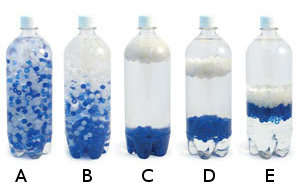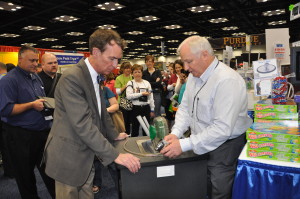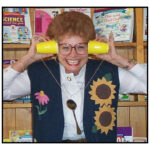October 9, 2014
 by: Donna Giachetti
by: Donna Giachetti
“In the spring
a young man’s fancy
lightly turns to thoughts of love.”
—Alfred, Lord Tennyson
Alfred may have a point, but these days our thoughts turn to darker, spookier things—zombies, ghouls, witches, monsters and ghosts (more about them later, scroll down to the end of the blog).

Why is autumn one of our favorite times of year?
Let us count the ways:
- A new school year…
- Cooler temperatures…
- Warm, cozy sweaters and boots…
- A procession of colorful fall foliage…
But best of all, there’s the anticipation of HALLOWEEN! What a wonderful time to be a mad scientist! Read the rest of this entry »
 Leave a Comment » |
Leave a Comment » |  Elementary level, experiments, Middle School level, static electricity | Tagged: brain, discrepant event, edible insects, Educational Innovations, experiments, fun experiments, halloween, hands-on activity, homeschool, parent friendly, PBL, phenomenon based learning, phenomenon-based science, science, Slime, static electricity |
Elementary level, experiments, Middle School level, static electricity | Tagged: brain, discrepant event, edible insects, Educational Innovations, experiments, fun experiments, halloween, hands-on activity, homeschool, parent friendly, PBL, phenomenon based learning, phenomenon-based science, science, Slime, static electricity |  Permalink
Permalink
 Posted by Tami O'Connor
Posted by Tami O'Connor
October 6, 2014
 by: Tami O’Connor
by: Tami O’Connor
After the birth of my youngest child I decided to get a teaching position at a school closer to home. Until that point, I had only taught in the elementary grades. As it turned out, a seventh grade science position had opened up in the middle school in the next town, and, shortly after I filed my application, I was called in for an interview. Because it was already early June when the opening occurred, things moved along rather quickly.
Read the rest of this entry »
 2 Comments |
2 Comments |  Elementary level, experiments, High School level, Middle School level, Physics | Tagged: air pressure, discrepant event, hands-on activity, microscale vacuum apparatus, PBL, phenomenon based learning, phenomenon-based science, science, vacuum jar |
Elementary level, experiments, High School level, Middle School level, Physics | Tagged: air pressure, discrepant event, hands-on activity, microscale vacuum apparatus, PBL, phenomenon based learning, phenomenon-based science, science, vacuum jar |  Permalink
Permalink
 Posted by Tami O'Connor
Posted by Tami O'Connor
May 20, 2014
 by: Tami O’Connor
by: Tami O’Connor
So, do you ever bring discrepant events into your classroom to capture your students’ attention? If so, the Poly Density Bottle should be on your list of must-haves! As you can see, this is a one-liter bottle filled with clear liquid. Floating at mid-bottle are two bands of beads, with blue on top of the white.

On its own, this is intriguing to many students. The head scratching begins, however, once the bottle is given a good shake. As soon as everything starts to settle, students will observe that the white beads now float at the top of the liquid while the blue beads sink to the bottom. The liquid, once clear, now appears to be slightly cloudy.
But wait, there’s more… After about 30 seconds something interesting begins to happen. The white beads gradually sink down, the blue beads gradually begin to float up, and the liquid above and below the beads is again clear. Now the stumper… Why is this happening? Read the rest of this entry »
 8 Comments |
8 Comments |  Chemistry, College level, density, Elementary level, High School level, Middle School level | Tagged: density, discrepant event, hands-on activity, homeschool, isopropanol and salt water, PBL, phenomenon based learning, phenomenon-based science, salting out, science, science table |
Chemistry, College level, density, Elementary level, High School level, Middle School level | Tagged: density, discrepant event, hands-on activity, homeschool, isopropanol and salt water, PBL, phenomenon based learning, phenomenon-based science, salting out, science, science table |  Permalink
Permalink
 Posted by Tami O'Connor
Posted by Tami O'Connor
May 9, 2014

Energy Sources in a Classroom – Scavenger Hunt
by: Roy Bentley
I had the opportunity to attend the NSTA Convention that was held last month in Boston. It was a great show with amazing displays, topics and speakers. And of course, we had the PowerWheel there demonstrating how easy it is to teach about energy.
One of the points that came up during the show that struck me as worth exploring further was when we asked the teachers we were working with was “what sources of energy do we have in the classroom” The teachers at the show answered the lights, the power outlets, the sunshine through the windows and possibly the forced air from the heating/cooling system. No one referred to the faucet. When the teachers were asked if they had ever had the electricity fail in the school they all answered yes. When asked if they had ever experienced a water failure in the school they all answered no. It was concluded that the most reliable source of energy in the room was the faucet/(gravity).
Here is a simple classroom or home activity to help students realize how many energy sources are around them all the time! Read the rest of this entry »
 1 Comment |
1 Comment |  Elementary level, energy, Middle School level, Physics | Tagged: energy sources, hydroelectric, hydropower, PBL, phenomenon based learning, phenomenon-based science, PowerWheel, Roy Bentley, science |
Elementary level, energy, Middle School level, Physics | Tagged: energy sources, hydroelectric, hydropower, PBL, phenomenon based learning, phenomenon-based science, PowerWheel, Roy Bentley, science |  Permalink
Permalink
 Posted by Tami O'Connor
Posted by Tami O'Connor
March 17, 2014
 by Janice VanCleave
by Janice VanCleave
I love the magnetic accelerator. In fact, I met friends at a restaurant yesterday and took the accelerator with me. We had a lot of fun predicting what would happen and testing our predictions. No formal steps….just making cool guesses and then discovering whether we were correct.
Yes! The steel ball shot off the end of the track and hit the floor a couple of times, but that just added to the excitement. It’s a small town and few are surprised that the eccentric science author is experimenting at the restaurant–again!

A parent came in with her daughter, a second grader. With the mother’s permission I invited the child to sit with us. The girl had sinus problems and didn’t feel well. She was a bit sluggish and her eyes looked dull, as one would expect. When I asked the child if she wanted to do some science experiments, her dull eyes brightened. She had not been present during the previous testing of the accelerator, but she was immediately interested.
Read the rest of this entry »
 Leave a Comment » |
Leave a Comment » |  College level, Elementary level, experiments, High School level, magnetism, Middle School level, Physics | Tagged: PBL, phenomenon based learning, phenomenon-based science, science |
College level, Elementary level, experiments, High School level, magnetism, Middle School level, Physics | Tagged: PBL, phenomenon based learning, phenomenon-based science, science |  Permalink
Permalink
 Posted by Tami O'Connor
Posted by Tami O'Connor
 by: Donna Giachetti
by: Donna Giachetti



 Posted by Tami O'Connor
Posted by Tami O'Connor  by: Tami O’Connor
by: Tami O’Connor


 by Janice VanCleave
by Janice VanCleave